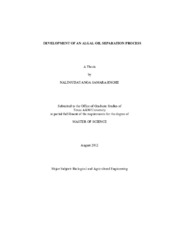| dc.description.abstract | Microalgae surpass the lipid productivity of terrestrial plants by several folds. However, due to the high moisture content and rigidity of algal cell walls, extraction of lipids from algae is still a significant technological challenge. In this research, an attempt was made to develop an algal lipid separation process which is energy efficient and effective.
Algal related research requires a unique set of knowledge in areas of algae culturing, measuring cell concentration, harvesting, cell rupturing and lipid quantification. The first section of this thesis focuses on the state of the art as well as knowledge gained during preliminary studies.
The second section of this thesis focuses on selecting a suitable measurement technique for quantification of algal cell disruption induced by homogenization. The selected method, hemocytometry was used to measure the degree of algal cell disruption induced by homogenization. In the third section, various homogenization treatments were evaluated for determining the fraction of cells disrupted during the homogenization.
Finally, lipid extraction efficiency of homogenized algae was evaluated using different extraction solvents under different homogenization conditions.
Preliminary research concluded that using cell counting is the most suitable technique to measure the effect of high pressure homogenization on concentrated microalgae.
It was observed that higher pressure and increased number of passes increase the degree of cell disruption. Concentrated, non stressed samples show best response to homogenization.
Out of the three solvents used for solvent extraction, chloroform gave a higher extraction yield at low intensity homogenizations. However at harsher homogenization levels the advantage of chloroform was not significant.
Lipid extraction efficiency increases with increased levels of homogenization. However, a significant increase in lipid yields was not detected beyond 20 000 psi and 2 passes of homogenization treatment. | en |


